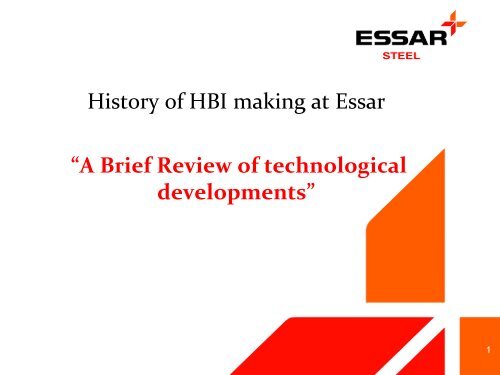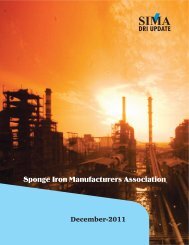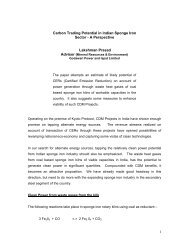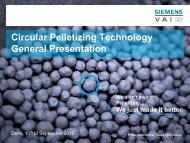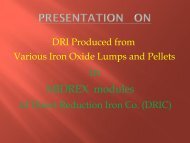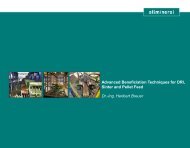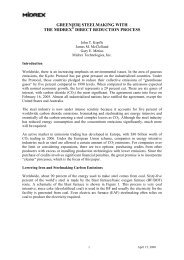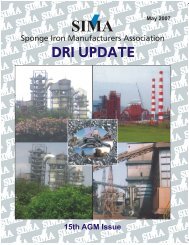Essar Steel
Essar Steel
Essar Steel
Create successful ePaper yourself
Turn your PDF publications into a flip-book with our unique Google optimized e-Paper software.
History of HBI making at <strong>Essar</strong><br />
“A Brief Review of technological<br />
developments”<br />
1
ESSAR Group- A diversified multinational conglomerate<br />
2
ESSAR Group- A diversified multinational conglomerate<br />
3
ESSAR Group- A diversified multinational conglomerate<br />
4
ESSAR Group- A diversified multinational conglomerate<br />
5
Various iron making Routes at EStIL- Hazira<br />
MIDREX<br />
6 Modules<br />
6.7 MTPA<br />
COREX<br />
2 Module<br />
1.74 MTPA<br />
BF-1.75 MTPA<br />
6
History of HBI making at EStIL- Hazira<br />
1988 Inception<br />
1989-1990 Erection and commissioning<br />
1991-1992 Expansion-I<br />
1992-1999 Innovations and improvements<br />
1999-2000 Breakthrough Concept of energy Saving<br />
2005-2011 Expansion-II<br />
7
Inception<br />
• 1980-81- KORF Engineering of Germany led a consortium to construct a Direct<br />
Reduced Iron (DRI) production facility, Nord Ferro Stahlwerke (NFW), at Emden,<br />
Germany.<br />
• 1981- NFW began early operations with two Midrex 400 series plants producing<br />
DRI but due to bad market scenario Module 1 operated for approximately nine<br />
months and Module 2 for approximately six months before the entire operation<br />
was closed.<br />
• 1982 to 1988- The plants were “mothballed”.<br />
• 1988- In late 1988 <strong>Essar</strong> contracted with the court receivers in Emden Germany<br />
for the purchase of the failed NFW direct reduction plants. Site preparation and<br />
civil work was taken up in earnest at Hazira with the first column for the Module 1<br />
furnace being erected in November 1988.<br />
8
Erection and commissioning<br />
• 1989- Hazira and Bombay became the<br />
focus of the project with civil works<br />
continuing and erection of structures at<br />
Hazira. Hazira was the focus of construction<br />
activities while procurement of new<br />
equipment was headquartered in the<br />
Bombay office. By the end of 1989 Module 1<br />
was complete mechanically and being<br />
commissioned in preparation for starting the<br />
process.<br />
9
Erection and commissioning<br />
• 1990- The first months of 1990 saw a<br />
flurry of activity as Module 1 was<br />
prepared for “start-up”. After months of<br />
around the clock activity Module 1<br />
achieved production status on March 28<br />
1990.<br />
• Module 2 was brought online in<br />
August 1990 completing the major part<br />
of the project.<br />
10
Expansion-I<br />
• 1991- A process license was signed with the technology supplier, Midrex, for the Module 3 project.<br />
Work began with the first furnace column being erected in January 1991.<br />
• 1992- Mod 3 was commissioned with production beginning in August of 1992 – only 19 months after<br />
erection of the first column.<br />
Module 1 2 3<br />
Capacity(MTPA) 0.44 0.44 0.44<br />
Innovations and improvements<br />
•1992- New hydrocarbon injection scheme installed in the furnaces to allow maximum Fe3C production<br />
(In-house design)- Mod- 1,2,3.<br />
•1992- Reformer design modified during construction to 336 tubes for a 16% increase in reformer<br />
capacity (In-house design) - Mod- 3.<br />
•1992- Liquid ring seal gas compressors replaced the screw type compressors – (In-house design)<br />
Features both energy savings and lower maintenance. - Mod- 3.<br />
•1992- Top gas duct redesigned to minimize oxide fines losses- (In-house design) - Mod- 3.<br />
11
Innovations and improvements<br />
• 1996- Turbo expander, a second hand plant was commissioned to take care of rich gas supply.<br />
• 1997- For process monitoring, process software package ,called FIXDMACS started for better<br />
Process evaluation with the help of historical data.<br />
• 1997- Thin wall refractory liner installed in the furnace increasing the furnace ID from 5.0 meters to<br />
5.15 meters – Midrex design.- Mod-1<br />
• 1999- Reformer expanded from 288 tubes to 336 tubes providing 16% additional reforming capacity<br />
(In-house design)- Mod-1<br />
• 1999- Oval Top Gas duct replaced standard off-take providing an additional 0.3 meters of reduction<br />
zone height – Midrex design- Mod-1,2.<br />
• 1999- Reformed Gas cooler was replaced by modified temperature control system – Midrex concept<br />
and (In-house design)- Mod-1,2,3.<br />
• 1999- Oxygen injection equipment installed to allow operation at elevated reduction temperatures to<br />
maximize production – Midrex concept and (In-house design). Mod-1,2,3.<br />
• 1999- Naphtha injection to the furnace cone trails were carried out. The concept was a success and<br />
the other modules have been similarly equipped. At this time naphtha can be utilized as a natural gas<br />
substitute in all three modules.<br />
• 1999- An additional set of heat recovery bundles were designed in house and placed in service to .<br />
improve energy efficiency (In-house design). Mod-2<br />
12
Breakthrough Concept of energy Saving<br />
• 1999-2000- Module 3 – Hot DRI was taken from the furnace discharge upstream of the briquetters<br />
for “hot charging” to an EAF. The trials were very successful and the facility was built into the other two<br />
modules.<br />
• Hot DRI (HDRI) development continues to be the top priority project at <strong>Essar</strong><br />
•Energy saving at EAF (@ 100 to 120 KWH/ton of liquid steel).<br />
•Zero %age moisture as against 1.5 to 2 % in HBI.<br />
•Reduction in briquetting system maintenance expenses.<br />
45 T Container<br />
13
Expansion-II<br />
• 2003 - Mod-4 erection started<br />
• 2004- Mod-4 commissioned in July<br />
• Capacity- 1MTPA<br />
• Modified design of heat recovery system owing to<br />
better heat utilization.<br />
• 2005 - Mod-5 erection started<br />
• 2006- Mod-5 commissioned in October.<br />
• Capacity- 1.6 MTPA<br />
• Equipped with VPSA system to help in<br />
consuming COREX gas<br />
Mod-4<br />
Mod-5<br />
14
Expansion-II<br />
• 2008 - Mod-6 erection started<br />
• 2010- Mod-6 commissioned in November.<br />
• Capacity- 1.7 MTPA (CDRI)<br />
• Equipped with VPSA system to help in<br />
consuming COREX gas<br />
• 2009 - VPSA erection started<br />
• 2011- VPSA commissioned in November.<br />
• Purpose -- Designed for removal of CO2 and<br />
H2O from Top Gas Fuel.<br />
• Capacity --- 1,35,000 Nm3/Hr<br />
• Power Consumption – 55 Kwh/t<br />
Mod-6<br />
VPSA<br />
15
Production across the Years<br />
16
Major cost drivers across the years<br />
17
Product quality across the years- Metallization<br />
18
Product quality across the years- Carbon<br />
19
Highlights and way forward<br />
• Crossed 50Mmt of production in FY 12-13.<br />
• Startup of 19MW power generation facility by utilizing flue gas waste<br />
heat of MIDREX plant.<br />
• Process tuned for safe use of BF grade pellets in our furnace.<br />
• Fine tuning the operation of VPSA to optimize it’s usage with the<br />
help of in-house talents and developed concepts.<br />
• Reduction in natural gas consumption per ton after usage of COREX<br />
gas In reformer.<br />
• Effective contribution towards ZERO waste policy of EStIL<br />
20
THANK YOU<br />
21


